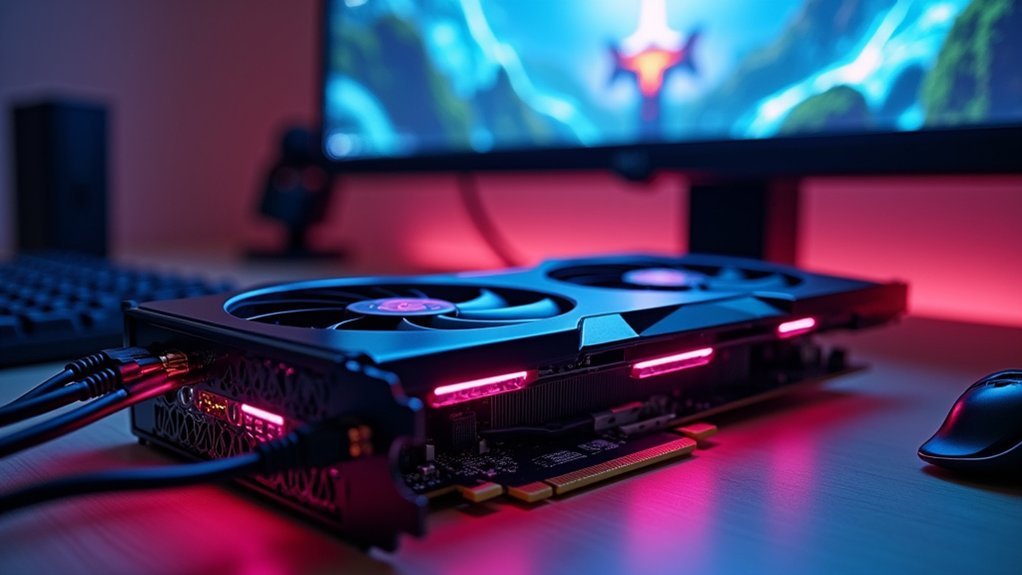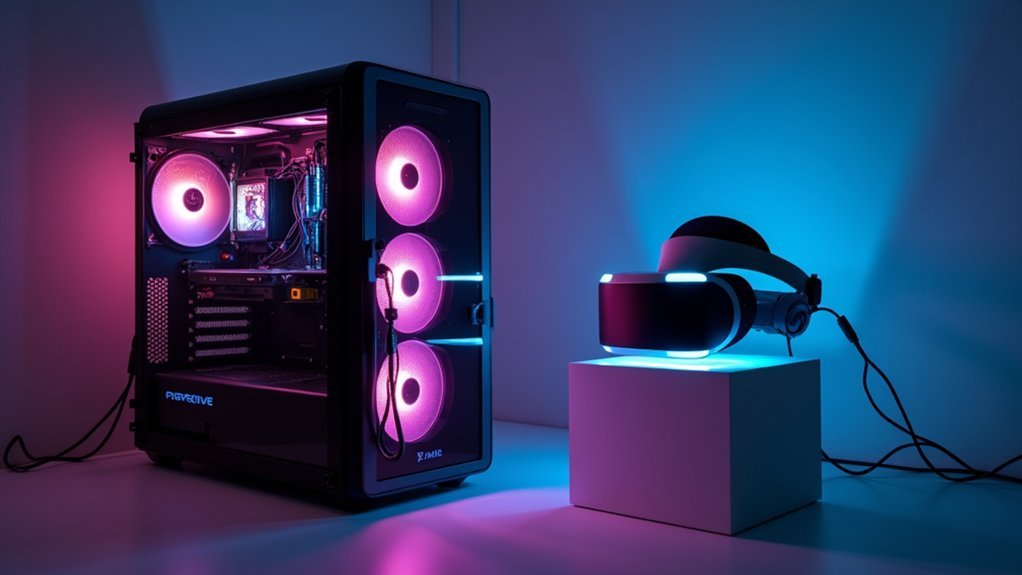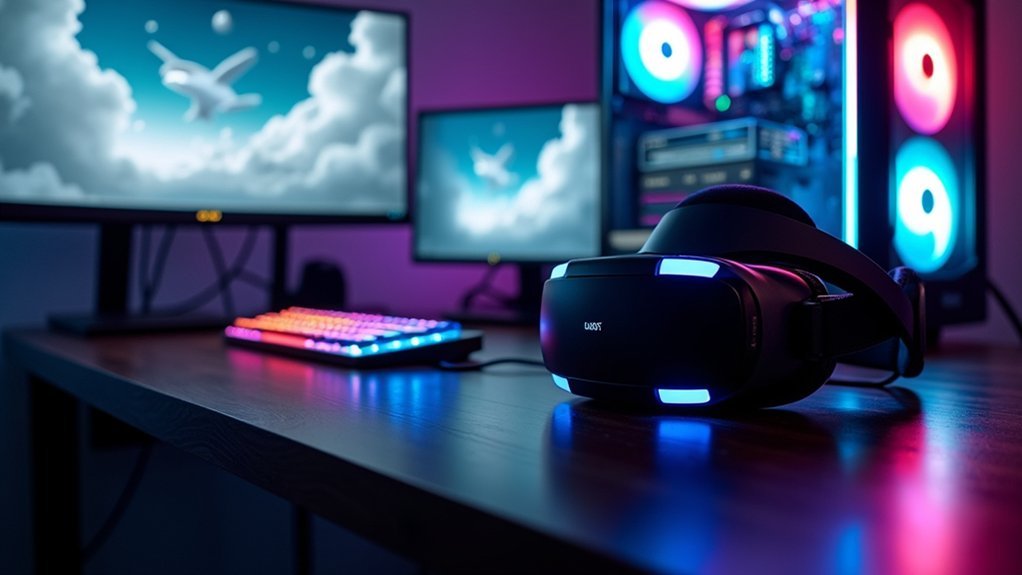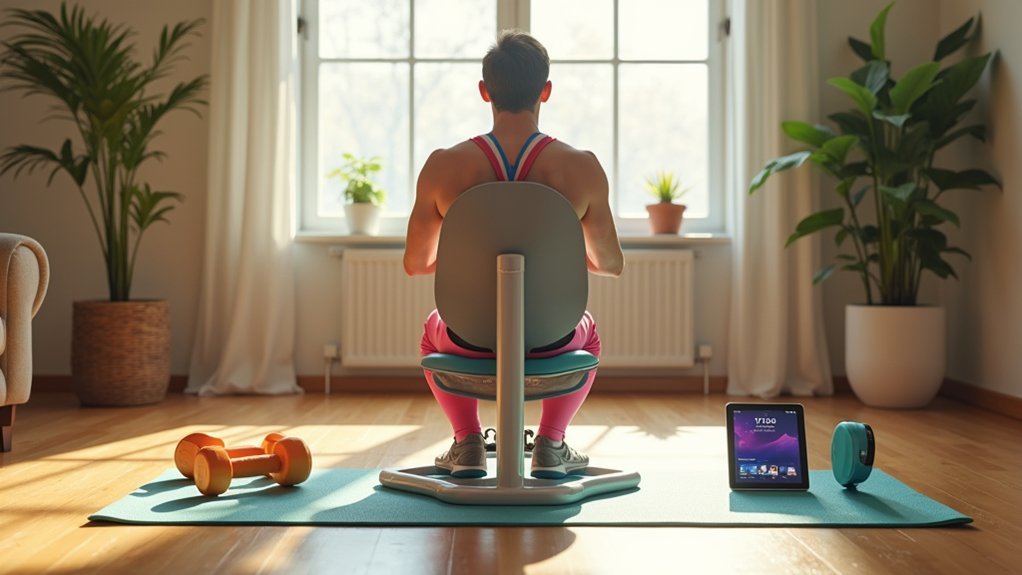You’ll need a modern graphics card like the NVIDIA GTX 1060 or AMD RX 480 as your baseline, paired with at least 16GB of RAM and an Intel i5-4590 processor. Make sure you’ve got USB 3.0 ports and HDMI 1.3 or DisplayPort connectivity for your headset. Test your current setup using SteamVR Performance Test before purchasing any VR equipment. Consider desktop PCs over laptops for better performance and upgradeability. The following sections will guide you through each specification requirement in detail.
Graphics Card Requirements for VR Performance

When choosing a graphics card for VR, you’ll need to meet specific minimum requirements to guarantee smooth gameplay without motion sickness-inducing frame drops. The minimum graphics card requirement starts with NVIDIA GeForce GTX 970 or AMD equivalent, though NVIDIA GeForce GTX 1060 or AMD Radeon RX 480 represents better recommended specifications for ideal experiences.
For high-end VR headsets like the Valve Index, you’ll want NVIDIA GeForce GTX 1070 or AMD Radeon RX 580 to be VR ready. However, graphics cards with 8GB or more VRAM are preferable for consistent frame rates.
Your GPU must be powerful enough to handle higher render resolutions, so consider RTX 3080 or greater for premium experiences. Verify your card provides adequate video output connections and delivers smooth performance across demanding VR applications.
CPU and RAM Specifications for Smooth VR Gaming
While graphics cards handle the visual processing, your CPU and RAM work together to guarantee VR applications run smoothly without stuttering or lag. For VR gaming, you’ll need minimum specs of an Intel i5-4590 or AMD FX-8350 CPU with 16GB RAM. However, recommended specs include an Intel i7-7700 or AMD Ryzen 5 1500X for peak performance and better multitasking capabilities.
| Component | Minimum | Recommended |
|---|---|---|
| CPU | Intel i5-4590 / AMD FX-8350 | Intel i7-7700 / AMD Ryzen 5 1500X |
| RAM | 16GB | 32GB |
Higher-end setups use Intel i7-12650H or AMD Ryzen 7 5800H processors with 32GB RAM for demanding applications. Since VR gaming requires maintaining 72-144 FPS at higher rendering resolutions, sufficient CPU power and RAM prevent choppy performance that can cause discomfort during sessions.
Essential Ports and Connectivity for VR Headsets

Beyond processing power, your VR setup hinges on having the right ports and connectivity options to link your headset with your computer. Most VR headsets require USB 3.0 ports plus additional USB 2.0 ports for peripherals and tracking devices.
VR connectivity demands proper USB 3.0 and 2.0 ports beyond just processing power for seamless headset and peripheral integration.
You’ll need compatible HDMI 1.3 or DisplayPort connection depending on your specific model. High-end headsets like the HTC Vive Pro demand DisplayPort connections, and you shouldn’t rely on adapters since they can cause detection problems.
Your computer system’s graphics card—whether it’s an NVIDIA GeForce RTX or AMD equivalent—must have sufficient available ports. Multiple connections are often necessary for peak performance.
Always verify current port requirements for your chosen VR headsets, as specifications can change with newer models and firmware updates.
Testing Your Current PC for VR Compatibility
How can you determine if your existing computer is ready for VR without buying a headset first?
You’ll need to run specific tests and check your hardware specifications. Download the NVidia Experience app or SteamVR Performance Test to evaluate your system’s VR capabilities.
Your graphics card should match or exceed an NVIDIA GTX 970, while your CPU needs Intel i5-4590 equivalent performance or better.
Check that you’re running Windows 10 or 11 with at least 8GB RAM.
Verify your graphics card has a compatible HDMI 1.3 or DisplayPort output – essential for headsets like the Oculus Rift.
Count your USB ports carefully; you’ll need at least one USB 3.0 port plus additional USB ports depending on your chosen VR headset’s requirements.
Desktop Vs Laptop Considerations for VR Gaming

Once you’ve confirmed your system meets VR requirements, you’ll face a fundamental decision: should you upgrade your desktop or invest in a VR-capable laptop?
Desktops clearly dominate VR gaming performance, delivering better specs per dollar and superior cooling capabilities that prevent thermal throttling during intense sessions.
You’ll also benefit from exceptional upgradeability—swapping graphics cards or CPUs becomes straightforward when VR demands evolve.
Laptops offer undeniable portability but compromise performance for mobility. Even high-end gaming laptops with powerful discrete GPUs struggle against thermal constraints in tight form factors.
While they’re convenient for on-the-go use, they can’t match desktop counterparts in raw VR performance.
Consider your priorities: choose desktops for maximum performance and future-proofing, or laptops for convenience and mobility.
Frequently Asked Questions
What PC Specs Do I Need for VR?
You’ll need at least an NVIDIA GTX 970 or AMD RX 480, Intel i5-4590 processor, 8GB RAM, HDMI 1.3/DisplayPort 1.2, USB 3.0 port, and Windows 10/11 for basic VR gaming.
How Powerful of a PC Do You Need to Run VR?
You’ll need at least an NVIDIA GTX 1060 or AMD RX 480 graphics card, Intel i5-4590 CPU, and 16GB RAM for basic VR. High-end setups require RTX 3080 and 32GB RAM.
What Qualifies as a VR Ready PC?
You’ll need a GTX 970 or better graphics card, Intel i5-4590 CPU minimum, 8GB RAM, HDMI 1.3/DisplayPort 1.2 output, USB 3.0 ports, and Windows 10 for VR-ready certification.
Is VR CPU or GPU Heavy?
VR’s primarily GPU-heavy since you’ll need powerful graphics processing for immersive environments and smooth frame rates. However, you can’t ignore your CPU’s importance, as it handles complex calculations and prevents bottlenecks that’d ruin your experience.





Leave a Reply